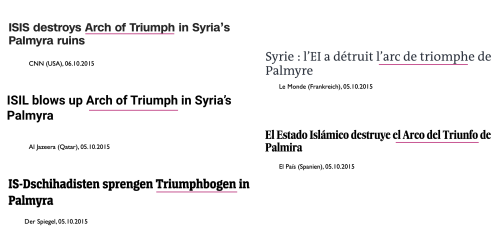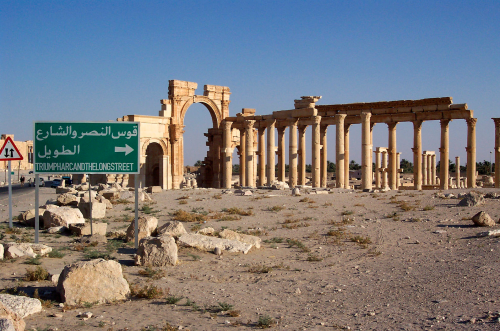The Pitfalls of “Charismatic Archaeology” - Part One: What’s in a Name?All right,
The Pitfalls of “Charismatic Archaeology” - Part One: What’s in a Name?All right, as promised, we’re going to take a look at the phenomenon of “charismatic archaeology” (Munawar 2017, 41) as it applies to the so-called Arch of Triumph in Palmyra, which was destroyed by Islamic State militants in 2015 and whose modern cultural context has seemingly superseded its archaeological context in the years since. Because there’s a lot to go over here, I’m going to have to split this up into a few parts. But the main takeaway of this series is that this arch—or tripylon—is still fascinating, even if it isn’t necessarily as ‘Roman’ as we are led to believe and that branding it as such does a disservice to the local Palmyrene builders responsible for its innovative construction in the late second to early third centuries AD (but more on that in later installments).We already encounter an issue with the classification of this monument as a triumphal arch. Once it was torn down by the Islamic State in October 2015, the tripylon was introduced to the public on a global scale. In their reporting, numerous international news outlets used this term to describe the structure. However, this inaccurate classification pre-dates the arch’s destruction: my thesis advisor told me that when she last visited Palmyra in 2005, the archaeological park guided tourists to the monument and the adjacent section of the city’s Great Colonnade with a sign that read “Triumph Arc (sic) and the Long Street.” That said, the vast majority of the archaeological literature that was written prior to 2015 more accurately designates it as simply a monumental arch or, more commonly in the German-speaking world, a tripylon.Other common misattributions the monumental arch is given are those of “Hadrian’s Arch/Gate” and the “Arch of Septimius Severus,” though the former is more often a fixture in the German-speaking world (where it’s called the Hadrian Bogen or Hadrianstor). In AD 129/130, Hadrian did himself travel to Palmyra, and during his stay, he granted the city his name (Hadriana Palmyra; Browning 1979, 27). And while it is true that there was an uptick in monumental civic construction and ‘Romanization’ in the city afterwards, the tripylon had not begun to be built until roughly the late Antonine period, around AD 175/180 (Barański 1995, Fig. 1; Tabaczek 2001, 128), so it could not have feasibly been built for Hadrian (in contrast to Hadrian’s Arch in Gerasa, Jordan). Similarly, this start date places its chronology too early to have been built for Septimius Severus, either, as his reign lasted from AD 193–211. That said, a number of scholars do date its construction to his reign or to post-212 more broadly (e.g. Browning 1979, 88; Burns 2017, 245; or Will 1983, 74). However, in doing so, they fail to take into consideration that a structure as large and complicated as the tripylon (more on that later) would have taken years and years to complete, and it was most likely finished sometime in the late Severan period (Tabaczek 2001, 38. 130). Therefore, any commemorative/honorific purpose for this arch is called into question (though statues to Odenathus and his family were placed in niches in the central passageway well after its initial construction in the mid-late 3rd century AD; Burns 2017, 245). The monument’s designation as a ‘triumphal’ arch or the Arch of Hadrian/Septimius Severus immediately brings it firmly into the realm of ‘Roman’ archaeology, but naming it as such ignores the tripylon’s indigenous Palmyrene context, which in itself tells a much richer story than its apparent association with the Roman Empire. It should be stressed that the term ‘triumphal arch’ was seldom used in antiquity (Cassibry 2018, 246) and that scholars from over a century ago had even expressed the need to use caution when defining these monuments as such (Densmore Curtis 1908, 27). Not only does this term signal the ‘Romanness’ of these structures, but it tends to evoke a sense of particular importance or gravitas to the modern layperson on account of how modern Western powers have adapted the architectural form and used it to express their own “cultural statement,” whether at home or abroad in colonized territories (e.g. the Arc de Triomphe in Paris or the Gateway of India in Mumbai; Ball 2016, 286).In reality, the eastern Roman territories of Syria and Provincia Arabia have no known ‘true’ triumphal arches, such as those that we’d associate with the city of Rome itself (e.g. the Arch of Septimius Severus or the Arch of Constantine; Ball 2016, 286), but there are three known commemorative/honorific arches to the emperors Trajan (Dura Europos) and Hadrian (Jerusalem and Gerasa; Segal 1997, 131). The point of such monuments was to serve as imperial propaganda “in Wort und Bild” (“in word and image”; Kader 1996, 184). As we will see in later parts of this series, this was not necessarily the case where Palmyra’s tripylon is concerned.Speaking of cultural statements and propaganda, it is also possible that the concept of triumph was used to the advantage of the Institute for Digital Archaeology of Oxford and Harvard Universities when it decided to use digital methodologies to create a physical reconstruction of the tripylon in 2016 (and believe me, there will be an entire separate post about everything that was wrong with this replica). The IDA’s branding of the tripylon as such in the wake of the Islamic State’s retreat from Palmyra may have delivered a different kind of political message in the sense that the arch and its subsequent reconstruction could represent a triumph of the Syrian people and their cultural heritage over the militants and their wanton destruction of it—perhaps as a 21st-century parallel to Zenobia’s liberation of Palmyra from the Roman Empire (Munawar 2019, 152). Whatever the reason, the emphasis on the monument’s charismatic ‘triumphal’ nature obfuscates its ancient urbanistic context, which will be discussed more in detail in the next part of this series. Thanks for reading! Works Cited: W. Ball, Rome in the East: The Transformation of an Empire, 2nd Edition (London 2016). M. Barański, The Great Colonnade of Palmyra Reconsidered, Aram Periodical 7(1), 1995, 37–46. R. Burns, Origins of the Colonnaded Streets in the Cities of the Roman East (Oxford 2017). I. Browning, Palmyra (Park Ridge 1979). K. Cassibry, Reception of the Roman Arch Monument, AJA 122 (2), 2018, 245–275. C. Densmore Curtis, Roman Monumental Arches (New York 1908). I. Kader, Propylon und Bogentor. Untersuchungen zum Tetrapylon von Latakia und anderen frühkaiserzeitlichen Bogenmonumenten im Nahen Osten (Mainz am Rhein 1996). N. Munawar, Reconstructing Cultural Heritage in Conflict Zones: Should Palmyra be Rebuilt?, EX NOVO Journal of Archaeology 2, 2017, 33–48. N. Munawar, Competing Heritage: Curating the Post-Conflict Heritage of Roman Syria, Bulletin - Institute of Classical Studies 62(1), 2019, 142–165. A. Segal, From Function to Monument: Urban Landscapes of Roman Palestine, Syria and Provincia Arabia (Oxford 1997). M. Tabaczek, Zwischen Stoa und Suq. Die Säulenstraßen im Vorderen Orient in römischer Zeit unter besonderer Berücksichtigung von Palmyra (Diss. University of Cologne 2001). E. Will, Le développement urbain de Palmyre, Syria 60, 1983, 69–81. Image Source: x (the first is from a PowerPoint I presentation I gave in January) -- source link
#archaeology#classical archaeology#syrian archaeology#palmyra#ancient history#ancient rome

